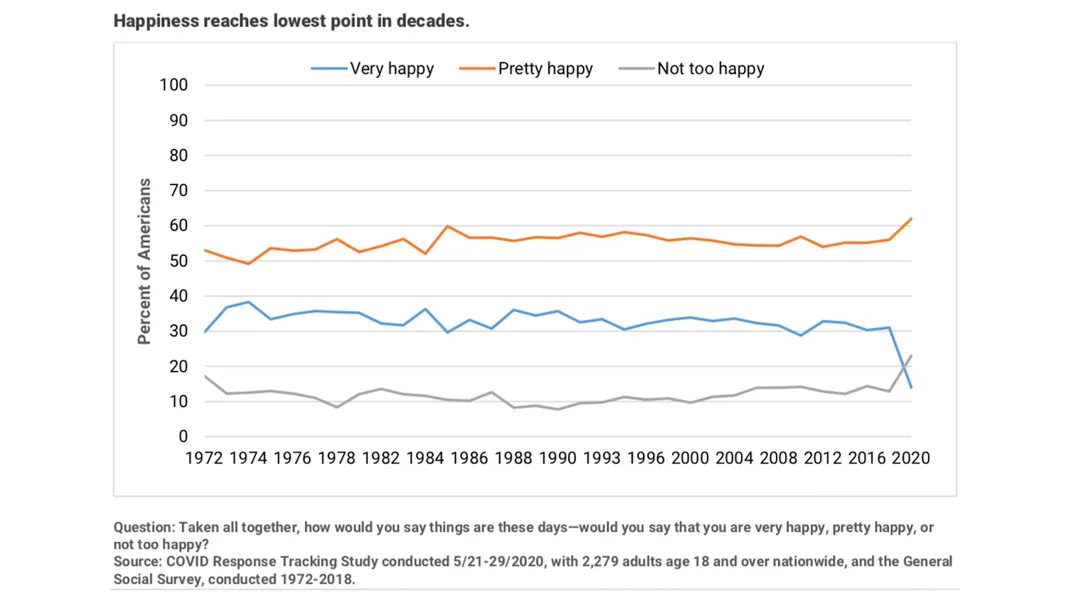New Research Suggests We’re Living in Historically Unhappy Times
A tool that analyzes tweets and a study from University of Chicago researchers show that Americans’ happiness has reached new lows in recent weeks
:focal(1581x590:1582x591)/https://tf-cmsv2-smithsonianmag-media.s3.amazonaws.com/filer/03/4a/034a597e-37bc-4a07-8cbe-a98d49b80bb5/happiness_on_twitter_graphed_since_2008.png)
If months of living through the COVID-19 pandemic and the recent endless cycle of news regarding police brutality has you feeling low, you’re not alone, researchers say. Two pieces of research released this week suggest that Americans are experiencing a historic period of unhappiness.
In an interview with Giuliana Viglione for Nature, researchers described the two weeks following May 26 as the “saddest” ever on Twitter. Chris Danforth and Peter Dodds, both mathematicians at the University of Vermont in Burlington, track the relative happiness or sadness of Twitter in multiple different languages using a tool called the “hedonometer,” reports Viglione.
Developed in 2008, the tool analyzes a randomly sampled 10% of tweets in a given language each day. It compares the words in the tweets to a database of more than 10,000 words that a group of 50 people rated on a scale of happy (9) to sad (1), according to the tool’s website.
The researchers noted a large, sustained drop in happiness on English-language Twitter in mid-March, as the COVID-19 pandemic started to intensify in United States. Then, on May 25, Minneapolis police officer Derek Chauvin killed George Floyd, sparking protests against police brutality in every state and triggering a flood of activism and anger online. In the following days, the hedonometer recorded its most negative reading ever—the “saddest day in the history of Twitter,” the researchers claimed in a Tweet.
A new all-time low for the Hedonometer, as happiness levels continue to drop in the days after George Floyd’s murder.
— hedonometer (@hedonometer) May 30, 2020
Lower than the shock of the coronavirus pandemic.
Lower than the mass shooting in Las Vegas in 2017. pic.twitter.com/39fEgce4cu
The words “murder,” “racist” and “sad” were all trending in the days following George Floyd’s killing, as protests began to take hold across the country, according to a Tweet.
“Hedonometer is reflecting Twitter’s live blog of societal disruption: the pandemic, pervasive structural racism, embarrassingly inadequate leadership, not to mention climate change or economic inequality,” Danforth tells Jason Murdock of Newsweek. “Sports, music, and live entertainment typically comprise a good portion of Twitter activity. Since the pandemic took hold in March, very few of these leisure activities have been available for discussion on social media.”
But describing the huge influx of tweets as just “sadness” might obscure a key part of the story. A surge of future-oriented activism has also been taking place on social media in recent weeks. As Desmond Patton, a social scientist at Columbia University, tells Nature: “It’s one thing to tell the world ‘this is the saddest week.’ […] But also in the saddest week, you have thousands and thousands of people who are now activated and moving towards equality and social justice.”
A Pew Research Center survey in 2019 found that just about 22 percent of American adults use Twitter. But the hedonometer’s results align with other studies of American wellbeing over time, including recently released data from the COVID Response Tracking Study conducted by NORC at the University of Chicago. A survey of 2,279 adults in early May 2020 found that Americans are the unhappiest they’ve been in the nearly five decades, reports Tamara Lush for the Associated Press.

Just 14 percent of Americans say they are “very happy,” compared to 31 percent of Americans who described themselves as such in 2018. According to the AP, the percentage of “very happy” people has never dipped below 29 percent since NORC began conducting these surveys in 1972.
It seems that people are also feeling the effects of social distancing, according to the University of Chicago statement. About twice as many Americans also reported feeling isolated in May, up to 50 percent compared with just 23 percent from the same time in 2018—perhaps unsurprising given the social distancing measures in place to keep most people apart.
The University of Chicago study was conducted before the killing of George Floyd and the eruption of nationwide protests in late May. However, other studies suggest that the one-two punch of recent events has fallen especially hard on black Americans. Multiple studies have shown that racial and ethnic minorities, especially black Americans, are dying at disproportionately large rates from COVID-19, per the Centers for Disease Control and Prevention. Additionally, a recent Census Bureau study showed that instances of depression and anxiety spiked among black Americans in the wake of the killing of George Floyd, report Alyssa Fowers and William Wan for the Washington Post.
/https://tf-cmsv2-smithsonianmag-media.s3.amazonaws.com/accounts/headshot/nora.png)
/https://tf-cmsv2-smithsonianmag-media.s3.amazonaws.com/accounts/headshot/nora.png)